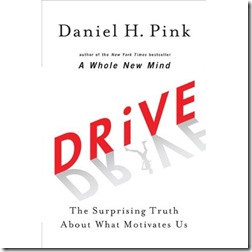 Gary Cohen: Dan, thank you for your willingness to share your thoughts with our readers on productivity motivation. Your new book, Drive: The Surpising Truth About What Motivates Us, is a terrific read. I will be doing a full review of the book later this month for our next CO2 Leadership Newsletter. In your book, you introduce the concepts of Motivation 2.0 and Motivation 3.0 which are all about productivity motivation. How would you describe the difference between them?
Gary Cohen: Dan, thank you for your willingness to share your thoughts with our readers on productivity motivation. Your new book, Drive: The Surpising Truth About What Motivates Us, is a terrific read. I will be doing a full review of the book later this month for our next CO2 Leadership Newsletter. In your book, you introduce the concepts of Motivation 2.0 and Motivation 3.0 which are all about productivity motivation. How would you describe the difference between them?Dan Pink: Motivation 2.0 is built around our reward-and-punishment drive. It presumes the way that people perform at the highest level is by offering them carrots for the behavior you seek and sticks for the behavior you want to deter. That approach — that motivational operating system, if you will — can be effective for certain kinds of tasks. But for complex, creative, and conceptual tasks, it’s usually a bad idea. The better approach there is Motivation 3.0, which is built around another of our drives — our innate need to direct our own lives, to learn and create new things, and to do better by ourselves and our world.
What do autonomy, mastery, and purpose have to do with motivation?
 These three elements are at the heart of this newer, more effective approach to motivation. If we really want high performance — especially on complex, creative, and conceptual work — people have to have freedom to do work their own way. They must be able to make progress, to get better at something that matters. And they’re more likely to really excel if what they do is in the service of something larger than themselves.
These three elements are at the heart of this newer, more effective approach to motivation. If we really want high performance — especially on complex, creative, and conceptual work — people have to have freedom to do work their own way. They must be able to make progress, to get better at something that matters. And they’re more likely to really excel if what they do is in the service of something larger than themselves.My book, Just Ask Leadership, examines how leaders can increase alignment, engagement, and accountability by asking more and better questions. How might this approach align with Motivation 3.0?
It aligns extremely well. One of the simplest pieces of leadership and management advice I give is this: “Listen more, talk less.” Asking questions is a way to hone your listening and hear other voices rather than just your own.
It is not unusual for the science of a subject, in this case motivation, to appear far in advance of implementation. Is there anything particular to our culture that will affect this lag time, specifically as it relates to how we practice motivating others?
Interesting question. I’m not sure, actually. But cycle times for everything are accelerating. So there’s a chance, I guess, that once the science is exposed and revealed a little more clearly, organizations may move somewhat more quickly than in the past.
What is the danger for those of us who continue to only use the carrot-and-stick approach or move to only intrinsic motivation?
The danger of using only carrots and sticks is that they’re ineffective for many types of work. What’s more, they can bring a cascade of other negative consequences — locking people in to short-term thinking, tamping down creativity, and even enticing some people to cheat. The danger of using only intrinsic motivators is overlooking that money is a motivator. If you don’t pay people enough — if they’re not being compensated adequately or if they can’t support their family — you’re not going to get any motivation at all. The idea that intrinsic motivators can somehow substitute for fair pay is a colossal mistake.
What five tips do you have for organizations wanting to switch to Motivation 3.0?
- Understand the limits of carrots and sticks — and use them only where they’re effective.
- Do whatever you can to provide employees with more autonomy over their time, their team, their task and their technique.
- Encourage people to supplement traditional performance reviews by doing their own performance reviews — setting out their monthly goals, for instance, and self-evaluating at the end.
- Take a day when people can work on any idea they want — then show the results to the rest of the company the following day. These one-day sessions of intense autonomy — known as FedEx Days, because people have to deliver something overnight — have proven incredibly productive.
- Infuse the workplace with a purpose larger than simply making the numbers or increasing earnings per share by two cents this quarter. Supplement the profit motive with the purpose motive.
If you want a well written book that brings a fresh perspective on what drives you and your teams based on our current understanding of motivation, pick up Dan Pink’s Book Drive: The Surprising Truth About What Motivates Us.
Related Blog Post: Motivation Video by Dan Pink



